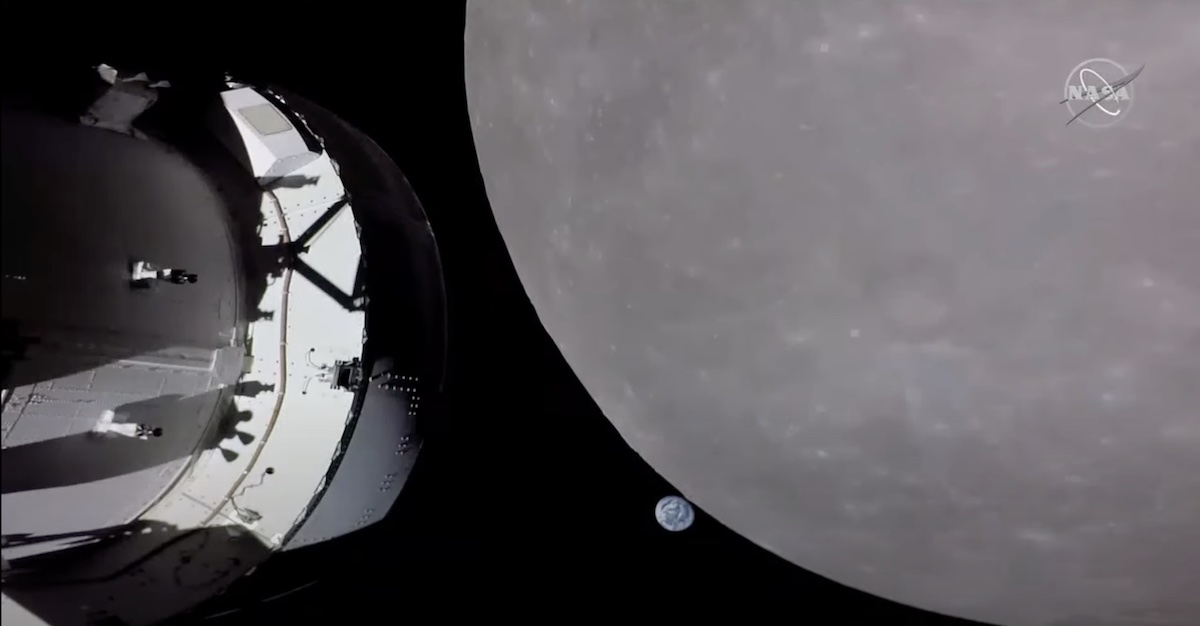
NASA’s unpiloted Orion spacecraft fired its main engine for two-and-a-half minutes Monday just before the capsule soared 81 miles from the surface of the moon, completing a flyby maneuver to bend its trajectory toward a distant orbit for more testing ahead of future lunar missions with astronauts.
The main engine burn at 7:44 a.m. EST (1244 GMT) Monday occurred while the Orion spacecraft flew over the far side of the moon, so NASA flight controllers in Houston had to wait for the capsule to emerge from behind the moon before confirming the outcome of the maneuver.
The Orion spacecraft’s engine firing Monday, called the Outbound Powered Flyby, was the most critical moment on NASA’s Artemis 1 mission since it blasted off last Wednesday from Kennedy Space Center in Florida. On its inaugural test flight, the huge new Space Launch System moon rocket released the Orion crew capsule on an on-target trajectory to begin a five-day cruise to the moon.
Artemis 1 is a test flight before NASA commits to flying astronauts on the SLS moon rocket and Orion spacecraft. If the Artemis 1 mission concludes successfully, the space agency plans to fly three U.S. astronauts and a Canadian astronaut around the far side of the moon on the Artemis 2 mission as soon as late 2024. That will be followed by lunar landing missions later in the 2020s, and construction of a mini-space station in orbit around the moon.
After its blastoff last week from Florida, the Artemis 1 mission’s Orion moon ship extended solar arrays from its European-built service module to generate electricity, and completed a series of course correction burns as it passed into the moon’s gravitational influence over the weekend. The outbound powered flyby, or OPF, burn used the orbital maneuvering system engine on the back end of the Orion service module. The OMS engine is a leftover from the space shuttle program, when it flew on 19 missions in orbit from 1984 until 2002.

The OMS engine fired up to produce about 6,000 pounds of thrust as the capsule sailed about 328 miles (528 kilometers) over the lunar surface. Over the course of the two-and-a-half minute firing, the engine increased the Orion spacecraft’s speed at a rate of more than 580 mph (933 kilometers per hour) and burned about 2,900 pounds (1,300 kilograms) of hydrazine and nitrogen tetroxide propellants, according to NASA. That’s about 20% of the Orion spacecraft’s entire fuel load.
Shortly after the burn, the Orion crew capsule reached its closet point to the moon — 81 miles (130 kilometers) over its cratered crust — at 7:57 a.m. EST (1257 GMT). About two minutes later, at 7:59 a.m. EST, mission control reestablished communications with the Orion spacecraft as capsule reappeared from behind the moon, enabling a direct radio link with a NASA Deep Space Network antenna in Goldstone, California.
A live video stream from the Orion spacecraft resumed once the Goldstone antenna locked onto the signal, showing a blue marble-like Earth suspended in the blackness of space. The Orion spacecraft later flew about 1,300 miles (2,100 kilometers) over the Apollo 11 landing site in the Sea of Tranquility. All of the maneuvers occurred as Orion traveled nearly a quarter-million miles from home.
While there are no humans on-board Artemis 1, there are three instrumented mannequins inside the Orion spacecraft’s pressurized cabin to gather data on accelerations, vibrations, and radiation on the flight to the moon and back.
NASA mission control has re-acquired signals from the Orion spacecraft after passing behind the back side of the moon. Standing by for a report on the result of the Outbound Powered Flyby burn. https://t.co/Ie3TWpO5mP pic.twitter.com/YeS6IQz1CM
— Spaceflight Now (@SpaceflightNow) November 21, 2022
NASA confirmed Monday’s engine burn and flyby were successful, helping the Orion spacecraft leverage the moon’s gravitational force to direct it toward a distant retrograde orbit, or DRO, with an average distance of about 43,000 miles (70,000 kilometers) from the moon.
The next major maneuver on the Artemis 1 mission is set for Friday at 4:52 p.m. EST (2152 GMT), when the Orion main engine will again ignite for a burn lasting approximately a minute-and-a-half to nudge the spacecraft into the distant retrograde orbit. The DRO has its name because it is not a low-altitude orbit like the Apollo capsules of the 1960s and 1970s flew in, and because Orion will move around the moon in the opposite direction the moon travels around Earth.
Mission planners chose the orbit for several reasons. First, the Orion spacecraft’s propulsion system does not have the capability to steer the capsule into a low-altitude orbit around the moon as the Apollo missions did. And the DRO is stable because it is near the balance point between the pull of gravity from Earth and the moon, reducing the fuel Orion needs to burn to maintain its orbit once it arrives.
The Orion spacecraft will spend about six days in the distant retrograde orbit performing tests and checkouts. It will reach its greatest distance from Earth next Monday, Nov. 28, at more than 268,500 miles (432,000 kilometers). On Dec. 1, after completing a half-lap around the moon, the capsule will fire its engine again to exit the distant retrograde orbit and swing back toward the moon for another low-altitude powered flyby Dec. 5 on the return leg to Earth.
Splashdown of the Orion capsule in the Pacific Ocean is scheduled for Dec. 11.
Email the author.
Follow Stephen Clark on Twitter: @StephenClark1.
from Spaceflight Now https://ift.tt/RvXpjPZ
via World Space Info







0 comments:
Post a Comment